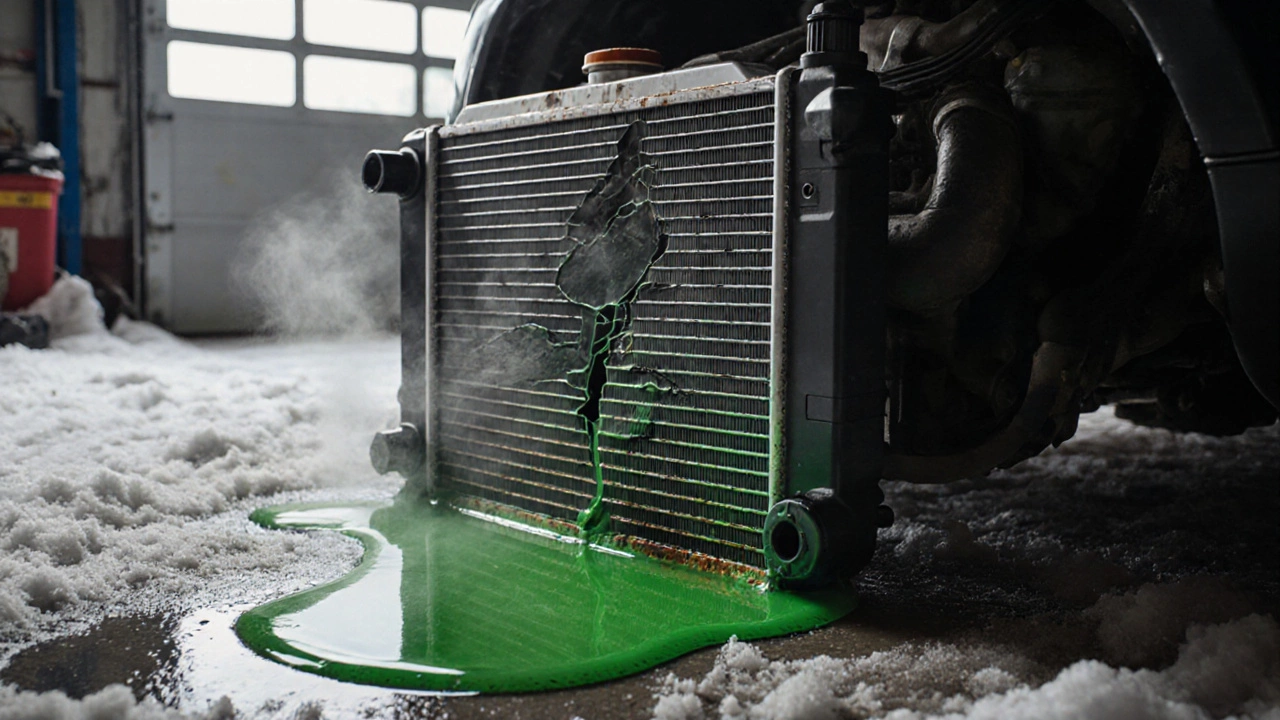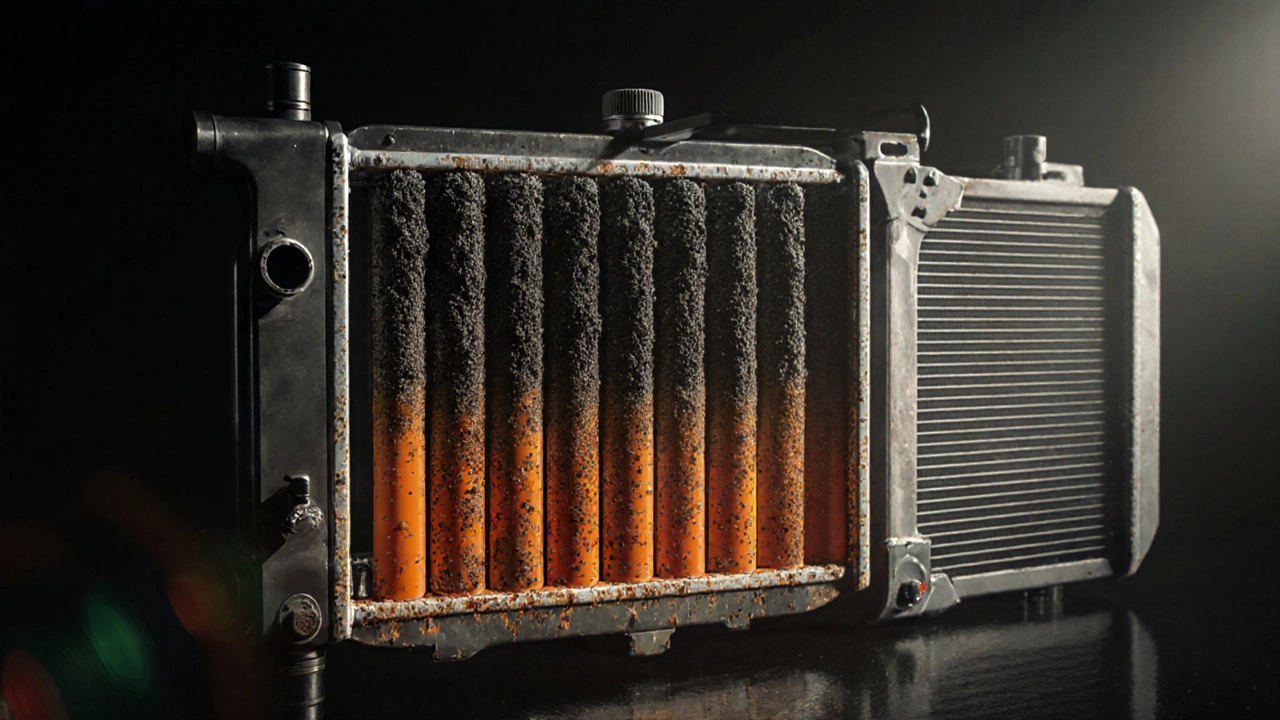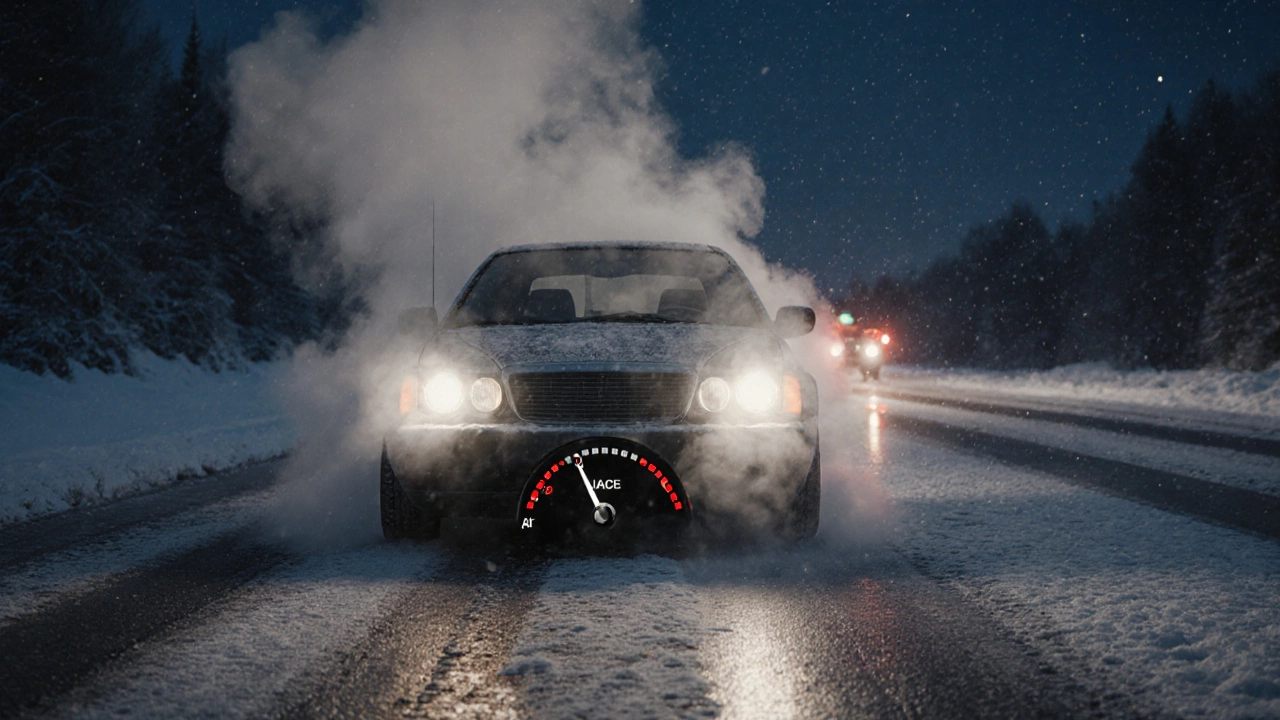 Nov, 20 2025
Nov, 20 2025
Radiator Health Assessment Tool
Check the symptoms below to assess your radiator's condition. Select all that apply:
If your car keeps overheating, or you’re seeing puddles under your hood, your radiator might be the culprit. It’s one of the most ignored parts in your engine system-until it fails. And when it does, you’re left stranded, with a bill that could easily hit $1,000. The good news? You don’t need a mechanic to spot the early signs. Most bad radiators show clear warning signs long before they break down completely.
Your Engine Keeps Overheating
Overheating is the most obvious sign. If your temperature gauge climbs into the red zone, or you see the warning light flash, your radiator is likely failing. But don’t assume it’s just low coolant. A radiator that’s clogged, leaking, or has internal corrosion can’t move heat away from the engine-even if the coolant level is full. In Hamilton winters, this often happens after a few cold snaps. Ice and road salt build up inside the radiator tubes, blocking flow. By the time you notice the gauge climbing, the damage is already done.
Coolant Is Leaking Under Your Car
Look under your car after it’s been parked for a few hours. If you see a bright green, orange, or pink fluid pooling near the front, that’s coolant. Radiators are made of aluminum and plastic, and over time, the seams crack or the tanks corrode. A small drip might seem harmless, but it’s not. You’re losing coolant slowly, which means your engine runs hotter. By the time you’re adding coolant every week, your radiator is already failing. Check the radiator itself-not just the hoses. A leak right at the bottom corner of the radiator tank is a dead giveaway.
Discolored or Sludgy Coolant
Open your coolant reservoir when the engine is cold. Fresh coolant should look clean, like apple juice. If it’s brown, muddy, or has a thick sludge floating in it, your radiator is rusting from the inside. Rust forms when old coolant breaks down and stops protecting the metal parts. This sludge clogs the narrow cooling passages inside the radiator. Even if you flush the system, the rust stays. That’s why a radiator with sludgy coolant rarely fixes itself. Most mechanics will tell you to replace it outright.

Steam or Smell Coming from the Engine
That sweet, syrupy smell? That’s burning coolant. If you catch it early, it’s just a small leak. But if you see white smoke puffing out from under the hood-or worse, steam rolling out while driving-you’re in serious trouble. Steam means coolant is turning to vapor because the radiator can’t cool it. This usually happens when the radiator core is blocked or the cap isn’t sealing. In cold weather, you might not notice until you’re stuck on the 403. Don’t wait for steam. If you smell coolant while driving, pull over and turn off the engine.
Visible Damage on the Radiator
Pop the hood and look at the radiator. Look for dents, cracks, or bent fins. Even a small dent from a rock or road debris can crush internal tubes. The plastic end tanks are especially weak-they crack after years of heat cycles. If you see any cracks, even hairline ones, the radiator is done. You can’t glue them. You can’t patch them. And if the fins are bent so badly that you can’t see through them, airflow is blocked. That means your engine runs hotter, even with a working fan.
Low Coolant Levels Despite Regular Refills
If you’re topping off your coolant every few days, something’s wrong. A bad radiator doesn’t just leak externally-it can also have internal leaks. Coolant might be seeping into the engine oil, or into the combustion chamber. That’s why your oil might look milky, or you’re seeing white smoke from the tailpipe. These are signs of a cracked radiator or head gasket failure. But if your radiator is old and you’re seeing coolant loss without visible leaks, the radiator is the first place to check. A pressure test at a shop will confirm it.

Your Car Has Over 100,000 Kilometers and Has Never Had the Radiator Replaced
Radiators don’t last forever. Most last between 8 and 12 years, or 100,000 to 160,000 kilometers. If your car is older than that and you’ve never replaced the radiator, you’re playing Russian roulette. Even if it’s not leaking now, the internal corrosion is building. In Canada, where we use salt on roads and face extreme temperature swings, radiators wear out faster. A 2015 Honda Civic with 140,000 km might still run fine-but if the coolant looks dirty and the temperature gauge creeps up on highway drives, it’s time. Waiting until it fails means you’ll be towing it to a shop in the middle of a snowstorm.
What to Do Next
If you’ve noticed even one of these signs, don’t ignore it. Start with a visual inspection. Check for leaks, look at the coolant color, and see if the radiator fins are bent. Then, have a shop do a pressure test. It costs about $50 and tells you if the radiator is holding pressure. If it’s not, replacement is your only option. Don’t try to repair it. Replacing a radiator in a typical compact car costs between $400 and $700, including labor. But letting it fail could cost you $2,000 in engine damage.
When you replace it, go with an OEM or high-quality aftermarket radiator. Cheap ones from discount auto parts stores often fail within a year. Stick with brands like Denso, Modine, or Spectra. And always flush the cooling system when you install a new radiator. Old sludge will clog the new one if you don’t.
Prevention Tips
Replace your coolant every 40,000 to 60,000 kilometers. Use the type your owner’s manual recommends. Don’t mix colors. Don’t top off with water unless it’s an emergency. Keep the radiator area clean-dirt and bugs block airflow. And if you drive in winter, rinse the front of your car after heavy snow. Salt accelerates corrosion.
A radiator doesn’t just cool your engine. It keeps your entire car running. Ignoring the signs won’t make the problem go away. It’ll just make it more expensive.
Can a bad radiator cause my car to stall?
Yes. If your radiator fails and your engine overheats badly, the car’s computer may shut down the engine to prevent damage. This is called thermal shutdown. You might lose power while driving, especially on highways. It’s not a mechanical failure-it’s a safety feature. But it still leaves you stranded.
How long does a radiator replacement take?
For most cars, a radiator replacement takes 2 to 4 hours. It’s not a quick job. The mechanic has to drain the coolant, remove the fan shroud, disconnect hoses and electrical connectors, and sometimes even take out the air conditioning lines. In colder climates like Hamilton, they’ll also check the thermostat and water pump while they’re in there.
Is it safe to drive with a bad radiator?
No. Even a small leak or minor clog can cause your engine to overheat in minutes. Driving with a bad radiator risks warping the cylinder head, blowing the head gasket, or seizing the engine. These repairs cost thousands. It’s never worth the risk.
Can I flush my radiator myself to fix it?
You can flush the system, but it won’t fix a cracked tank, clogged core, or internal corrosion. Flushing removes old coolant and some debris, but if the radiator metal is already eaten away, you’re just cleaning a broken part. If your coolant looks like mud or you’re losing coolant without leaks, flushing won’t help. Replacement is the only solution.
Why does my radiator leak only when the engine is hot?
Coolant expands when it heats up, increasing pressure inside the radiator. A small crack or weak seam might seal when cold but open under pressure. That’s why you don’t see leaks overnight but notice puddles after a long drive. It’s a classic sign of a failing radiator-pressure testing while hot is the only way to catch it.